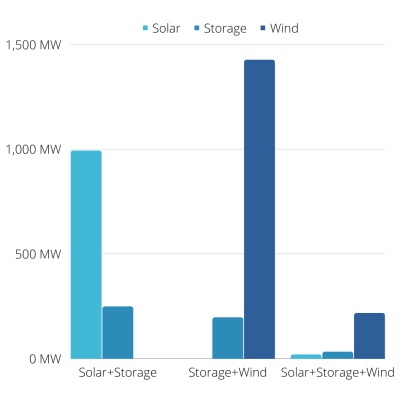Hybrid Power Plants are Here to Stay
 | Delainey Thorud, Manager, Membership and Operations |

 | Delainey Thorud, Manager, Membership and Operations |
Have you ever heard of hybrid power plants? They are relatively new, but are going to become the power plants of the future. Hybrid power plants are power generation systems that combine two or more types of electricity generation or, more commonly, combine electricity generation with battery storage at the same location. Hybrid power plants generally consist of renewable energy technologies such as solar panels or wind turbines paired with energy storage facilities. The solar panels and wind turbines generate electricity while the sun is shining or the wind is blowing and any excess that's not used right away is stored in the battery. Then, in the evening when the sun is going down or at times when there is little wind in the area, energy reserves held in the battery can be released, providing electricity to consumers as needed. This greatly enhances the reliability of the grid while delivering cost effective electricity to customers.
These days, utilities are retiring power plants that rely on fossil fuels largely for economic and environmental reasons. Coal and gas prices rise and fall based on a variety of factors and contribute to air and water pollution. Wind and solar, however, have zero fuel costs and no direct emissions. This means that utilities and corporations can purchase renewable energy at a set price for a set period of time. This gives them certainty; and everybody likes that. Additionally, wind and solar production costs have come down and they are now the least expensive form of new energy generation.
Storage is a Game-Changer
Enter battery storage, which can store low-cost, clean, renewable energy for hours at a time, and now you really have a game-changer in the renewable energy industry. Storage can help fill the gaps in variable energy resources, keeping the electric grid cleaner, longer, and more reliable. Another benefit to battery storage is that it helps to reduce unused renewable energy.
Oftentimes, renewables will over-produce and the excess energy has nowhere to go. Over-production can occur when energy demand is low or transmission capacity is congested or not available. During these times, the low-cost, clean energy that cannot be added to the grid will be wasted. Energy storage allows us to capture this unused energy and store it until it is needed. This not only reduces the amount of wasted clean energy but can also reduce the amount of fossil fuel resources on the grid.
Battery storage also increases the reliability and responsiveness of the grid. When unexpected events such as extreme weather cause a disruption of service, storage is able to step in and help fill the gaps. Battery storage holds clean energy until it is needed on the grid and can be released quickly and on short notice to meet changing needs. This ensures that there will be a consistent, reliable stream of power even when unexpected fluctuations in demand occur.
Hybrids add value
Hybrid projects are often more cost effective than standalone generation and storage projects. There is an increased cost of constructing solar or wind farms when battery storage is added, but the value of the project that is being created also increases. That's because hybrids make more efficient use of the transmission system. Plus, battery storage is not dependent on the weather and can be called upon to deliver power when needed. This makes storage "dispatchable" and that added flexibility has a higher value to the system as a whole.
Growth of Hybrids

While the hybrid market is still relatively small today, there has been a dramatic increase in the number of hybrid power plants that are being planned across the county. At the end of 2020, there were 73 installed solar-plus-storage projects providing 992 MW of solar and 250 MW of battery storage nationwide. There were also 17 wind-plus-storage projects providing 1,425 MW of wind and 198 MW of storage. Additionally, there were two solar, wind and storage hybrid projects providing 218 MW of wind, 21 MW of solar and 34 MW of storage.
According to the American Clean Power 2021 Annual Report, hybrid projects now represent 32% of the projects in queues waiting to be connected to the U.S. grid. In the Midcontinent Independent System Operator (MISO) region, which includes the central region of the country, 23% of projects waiting to be connected to the grid are hybrid; 18% are solar-storage hybrids and 5% are wind-storage hybrids. Solar-plus-storage hybrids are the most common hybrid combination and almost half of all battery storage projects waiting to be added to the U.S. grid are paired with solar.
Despite seeing significant growth in hybrid projects, there is still a long way to go before hybrid power plants can be fully integrated into our existing energy infrastructure. As CGA Policy Associate Madelyn Smerillo explains in her recent blog, all resources on the grid must have established "rules of the road" that help utilities and grid operators use them effectively. While the Federal Energy Regulatory Commission (FERC) has ordered all grid operators to provide market rules for stand-alone storage, most regions of the country are still working to develop and implement them. Hybrid resource market rules have even farther to go, and more coordination is needed to see this technology to fruition. Clean Grid Alliance is working in the stakeholder process at MISO (Midwest regional grid operator) to push for the development and implementation of these market rules in order to open up more opportunities for [hybrid] projects in the near future. New [hybrid] resources will play an important role in the changing resource mix in the Midwest.
It's a fact. Hybrid projects are here to stay. And that's a good thing!